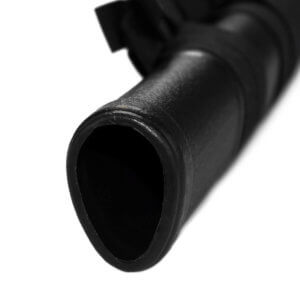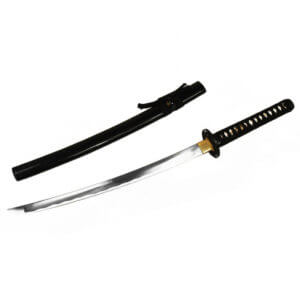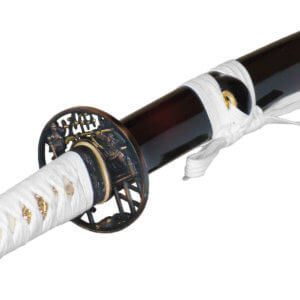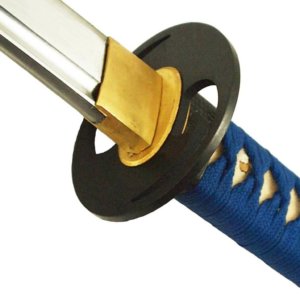Here you will find some terms related to samurai swords. If you think that we should include a particular term in the collection, you are welcome to write to us and we will add it.
So that the list does not become infinitely long, we have deliberately omitted certain areas, such as the naming of many Boshi- or Hamoncharacteristics. These topics are covered in the respective samurai sword wiki topics on our site. Mentioning them here would go beyond the scope of this page.
A brief explanation of the terms:
- Der/Die/Das: Since there are no articles in the Japanese language, we use the article that matches the respective term in German usage. E.g.: the saya
- Stress: The correct stress of words plays an important role in Japanese. Macron and circumflex are used to mark pronunciation. To simplify input, we do not use any of these markings in the glossary. Our glossary is intended to explain terms and not necessarily to teach the correct Japanese pronunciation.
- Singular and plural: In the Japanese language, terms in the singular correspond to terms in the plural, which is why we always use the singular form for all Japanese terms, e.g. one katana in the singular and two katana in the plural: One katana in the singular and also two katana as a plural word.
Aikuchi |
Mounting style without stitch plate |
Aizame |
Blue handle inlay |
Ana |
Translation = hole, e.g. the hole for Mekugi = Mekugi Ana |
Ato Mei |
Subsequent signature |
Banzashi |
A type of mounting for swords carried by the samurai of the Edo fortress. |
Bo Hi |
Continuous fuller from the blade tang to the ridge at the blade tip |
Boshi |
Hardening line at the blade tip |
Buke-Zukuri |
Sword mount from the new era, in which the sword is worn on the belt with the edge pointing upwards. |
Choji |
Clove blossom used for the production of oil for sword care. However, the term is also often used when a mould has a corresponding appearance, e.g. choji hamon |
Chokuto |
Sword with straight blade |
Chu Kissaki |
"Medium-long" sword point. Corresponds to the designation Chu Gissaki. |
Daisho |
The two swords that a samurai classically carried, consisting of a long sword (katana) and a short sword (wakizashi) |
Daito |
The longer sword of the Daisho |
Fuchi |
Grip clamp between sword grip and blade |
Fuchi Kashira |
Set of handle clamp (Fuchi) and fitting at the end of the handle (Kashira) |
Fukura |
Bending of the cutting edge at the tip of the blade |
Fukura Kaku |
Round cutting edge at the tip of the sword |
Fukura Kareru |
Straight cutting edge at the tip of the blade |
Fukure |
Blister in the steel of a finished sword (defect) |
Fukurin |
Folded edge of a stitch blade |
Fukuro |
Silk sword pouch |
Futasuji Hi |
Two narrow fullers in the blade that run parallel to each other |
Gaiso |
Other term for more commonly used name Koshirae, the mounting of the sword |
Gaku Mei |
Signature that was removed and replaced during blade shortening |
Gendaito |
"Modern" sword that was manufactured after 1876 |
Gi Mei |
Forged signature. Corresponds to the term Nise Mei. |
Gin |
Japanese word for "silver" |
Gin Gise |
Lined or underlaid with silver |
Gin Mei |
Signature inlaid with silver |
Gitae |
Method of forging different types of steel together. Corresponds to the term kitae. |
Gomabashi |
Two parallel grooves in the blade |
Gunto |
Designation for the swords of the Japanese military after 1935 |
Gyo No Mune |
Blade back in the shape of an inverted V. Corresponds to the designation Iori |
Ha |
Cutting edge of the sword blade. Corresponds to the designation Hasaki. |
Habaki |
Blade ferrule between the blade and the blade |
Hada |
Surface structure of a sword blade |
Hada Aoshi |
"Blue" surface on a blade |
Hada Shiroshi |
"White" surface on a blade |
Hagire |
Cracks in the blade (defect) |
Hajimi |
Unclean areas of the hamon due to poor heat treatment during the forging process or excessive polishing (defect) |
Hamon |
The hardening line on the blade, which is also considered the blacksmith's signature |
Hamidashi |
Name for a very small blade and knives that have such a blade |
Ha Watari |
Blade length. Measured from the transition of the sword tang to the blade to the transition of the blade to the tip of the sword. Corresponds to the designation Nagasa |
Heito |
Pommel at the end of the handle. Corresponds to the designation Kashira |
Hi |
Groove in the blade |
Hineri Maki |
Simple cross binding of the handle winding |
Hira Maki |
Cross binding of the handle winding without twisting |
Hira Mune |
Flat blade back without inverted V. Corresponds to the term Kaku Mune |
Hira Zukuri |
Flat blade shape |
Hitsu |
Opening in the tsuba for by-knife. Corresponds to the designation Hitsu Ana |
Ho |
Blade of a by-knife |
Ho No Ki |
Magnolia wood, which is often used to make sword scabbards |
Hono To |
A sword dedicated to a temple or shrine |
Hon Sanmai Gitae |
Blade construction with three types of steel |
Horimono |
Engraving on the blade |
Horyo |
The overall dimensions of a sword |
Iai To |
Sword for sporting purposes |
Ichi Mai Boshi |
Blade tip area |
Ikari O Kassaki |
Large, curved sword tip |
Ikubi Kissaki |
Large sword point with straight edge |
In my |
Stamped signature |
Iori |
Blade back in the shape of an inverted V. Corresponds to the designation Gyo No Mune |
Iro |
"Colour" of the blade |
Irogane |
Generic term for materials other than iron that are used for the manufacture of fittings |
Itame Hada |
Blade surface with a texture reminiscent of wood grain |
Ji |
Blade surface |
Jigane |
Steel of the blade surface |
Jindachi |
Blade with old mount, which was worn with the blade pointing downwards. Corresponds to the designation Tachi. |
Kaga |
Bronze inlay for graver blades |
Kaigunto |
Modern naval swords |
Cake |
Japanese term for "sword stand" |
Kaku Mune |
Flat blade back without inverted V. Corresponds to the term Hira Mune |
Kamkura Bori |
Thin iron blade |
Kanagu |
Metal fittings of the assembly |
Kanagyu |
Fittings for swords with tachi mounting |
Kasaneme Ataru |
A sword that is even thicker than usual on the thick side |
Kashira |
Knob at the end of the handle. Corresponds to the designation Heito |
Katana |
Long sword with Buke Zukuri mount |
Kawagane |
Sword steel with high carbon content |
Keijo |
Shape of the blade |
Kesho Yasuri |
Decoration of the blade tang with file marks |
Ke Saya |
Old, decorated scabbard, partly covered with fur. This decoration was mainly used for tachi mounts. |
Kiku |
Shape of the chrysanthemum flower |
Kiku Gata |
Trefoil in the shape of a chrysanthemum blossom |
Kin |
Japanese term for "gold" |
Kin Fukurin |
Gold rim on engraving leaves |
Kin Gise |
Covered with gold or gold inlays |
Kin In Mei |
Stamp signature inlaid with gold |
Kinzogan Mei |
Signature inlaid with gold |
Kiri |
Horizontal file marks on the tang of the blade |
Kissaki |
Blade tip. Corresponds to the term Gissaki |
Kitae |
Method of forging different types of steel together. Corresponds to the term gitae. |
Kizu |
General term for defects in the blade |
Kobuse |
Relatively simple blade design |
Kodachi |
Short sword |
Kodogu |
Generic term for the fittings of a sword |
Kogatana |
Small by-knife that is often inserted into the sword or knife sheath of a katana or tanto |
Kogai |
Sword pin |
Koikuchi |
Literally translated "carp mouth". A term for the mouth of the sword scabbard. |
Kojiri |
End of the scabbard. Often decorated with horn or metal. |
Ko Kissaki |
Short sword point |
Koshirae |
The complete mounting of a sword (everything except the blade) |
Kozuka |
Handle of a small by-knife |
Kurigata |
Eyelet for attaching the strap to the scabbard |
Kyo Gunto |
Modern military sword |
Machi |
Groove at the transition from the centreboard tang to the blade |
Macaque |
Handle wrapping made from braided silk |
Maru Kitae |
Simple blade construction. Corresponds to the designation Maru Gitae. |
Maru Dome |
The round end of a gouge in the blade |
Maru Mune |
Rounded blade back. Corresponds to the designation So No Mune |
Masame Hada |
Straight grain of the blade surface |
Mei |
Signature in the sword hilt |
Mekugi |
"Pin" that holds the blade in the sword handle. Made of wood (usually bamboo) or horn |
Mekugi Ana |
Hole for the blade retaining pins |
Mekugi Nuki |
A small tool with which to remove the mekugi |
Menuki |
Decorative ornamental element for the handle |
Mitokoro Mono |
By-knife, sword pin and handle decoration (Menuki) by the same maker |
Mitsu Mune |
Sword back with 2 ridges. Corresponds to the designation Shin No Mune. |
Mokko Gata |
Form with 4 arches, the term is mainly used for tsuba |
Mono Uchi |
Striking area of the blade. The front quarter. |
Moroha Zukuri |
Blade shape with an asymmetrical double cutting edge |
Moto Haba |
Blade width at the transition from the centreboard tang to the blade |
Moto Kasane |
Strength of the blade |
Mumei |
Without signature of the fishing rod |
Mune |
Centreboard |
Mune Gane |
Steel used for the back of the blade |
Mune Machi |
Area of the blade where the back of the blade joins the habaki. |
Mune Saki |
Area of the blade where the back of the sword joins the tip of the sword |
Mune Yaki |
Hardening on the back of the blade |
Mu Sori |
Blade with hardly any curvature. The term is mainly used for knives. |
Nagasa |
Blade length. Measured from the transition of the sword tang to the blade to the transition of the blade to the tip of the sword. Corresponds to the designation Ha Watari |
Nakago |
The sword hilt |
Nakago Ana |
Opening in the blade through which the blade is inserted. |
Nanban Tetsu |
Imported steel |
Nodachi |
Large sword that was carried on the field. |
Nise |
Partial or total counterfeiting |
Nise Mei |
Forged signature. Corresponds to the term Gi Mei. |
Nishiki Zutsumi Saya |
Scabbard decorated with coloured brocade fabric |
Nishi No Uchi |
Rough Japanese paper |
Nugui Gami |
Japanese paper used in connection with sword care |
O |
Japanese term for "large" |
O Dachi |
Large Tachi sword. Corresponds to the term O Tachi. |
O Katana |
Large katana |
O Kissaki |
Large sword point |
O Suriage |
Generously shortened blade of a sword |
O Tachi |
Large tachi sword. Corresponds to the term O Dachi. |
O Wakizashi |
Large wakizashi |
Ryu Hitsu |
Opening for byknife and sword pin in the sword or knife sheath |
Sabi Nure |
Paint finish designed to imitate rust |
Sabi Tsuke Nakago |
Partially rusted centreboard tang |
Sageo |
Strap that is passed through the eyelet on the scabbard |
Saki Zori |
Sword with strongest curvature in the front quarter of the blade |
Sakura |
The cherry blossom. A very popular motif |
Same |
Rayskin, which is used, for example, for inlays in sword hilts or to decorate sword scabbards. |
Same Saya |
Sword scabbard decorated with ray skin |
Samurai |
Warrior of the Japanese feudal period. Can be compared in the broadest sense with the knight in Europe. |
Saya |
Scabbard |
Sensuki |
Grinding marks on the fishing rod |
Sentoku |
Japanese term for brass |
Seppa |
Washer on both sides of the stitch blade |
Seppa Dai |
Area of the tsuba that serves as a "platform" for contact with the washers (seppa) |
Shaku |
Japanese unit of length, often used to designate the length of blades. 1 Shaku = 30.3 cm |
Shingane |
Core steel (soft) in a complex blade structure |
Shin Gunto |
Military sword of the modern era from 1930 to 1945 |
Shin Ken (Shinken) |
Simple modern swords with a sharp blade used for sporting purposes |
Shin No Mune |
Sword back with 2 ridges. Corresponds to the designation Mitsu Mune. |
Shinobe Ana |
Additional hole for Mekugi for extra support |
Shinogi |
Ridge of the blade |
Shinogi Zukuri |
Blade with burr |
Shinsaku To |
Swords of the current era |
Shin Shinto |
Modern swords from the 18th to 19th century. Successors to the swords known as Shinto. |
Shin To (Shinto) |
Swords from the 16th to 18th century. This was followed by swords labelled Shin Shinto |
Shirasaya |
Simple mounting without details such as tsuba or decorations. Usually made of magnolia wood and used for the sale / storage of swords |
Shishi |
Lion dog. A breed of dog that is considered particularly noble and is a popular motif. |
Shoto |
Kure's sword in the Daisho |
Showato |
Mass-produced swords from 1926-1945 |
Shu Mei |
Lacquered signature |
Shunuri |
Red paintwork |
So No Mune |
Rounded blade back. Corresponds to the designation Maru Mune. |
Sori |
Curvature of the blade. Is determined by "drawing" a straight line from the tip of the sword to the tsuba and then drawing the distance to the furthest point at a 90 degree angle |
Tachi |
Blade with old mounting, which was worn with the blade pointing downwards. Corresponds to the designation Jindachi |
Tachi Koshirae |
Mounting of a tachi. Corresponds to the designation Tachi Goshirae. |
Tachi Mei |
Signature on the blade of a tachi |
Tamahagane |
Sword steel produced in the traditional way (Tatare) |
Tameshigiri |
Cutting test for swords |
Refuelling |
Literally means "small sword". A knife that is usually less than 30 cm long. Corresponds to the term tanto. |
Tanto |
Means "small sword". A knife that is usually less than 30 cm long. Corresponds to the term tank. |
Tartar |
A "melting furnace" in which iron sand is melted to produce the classic sword steel tamahagane |
To |
Any type of sword with a single-edged blade |
Token |
Generic term for any type of sword |
Torii Zori |
Blade curvature where the centre of curvature is in the centre of the blade |
Tsuba |
The blade of a sword |
Tsuka |
The hilt of a sword including decoration and fittings |
Tsuka Ito |
The band for the handle winding of a sword |
Tsuka Maki |
The handle wrap. There are many different ways to tie the strap for the handle wrap. |
Tsuno |
Japanese term for horn |
Tsunagi |
Wooden dummy blade. Used to hold a mount together without a real blade. |
Ubu Nakago |
Unshortened sword tang in original condition |
Uchigatana |
Early short sword that was often carried in addition to the tachi. |
Uchiko |
Fine sword powder used for sword care |
Wakizashi |
Short, one-handed sword. Usually between 30 and 70 cm long. |
Wari Bashi |
Chopsticks that were carried on the sword scabbard like by-knives |
Yasurime |
File marks on the sword tang, which are added to the signature as an identification mark |
Yokote |
Degree that separates the tip of the blade from the rest of the blade |
Yoroi Toshi |
Small knife intended for thrusting through armour |






